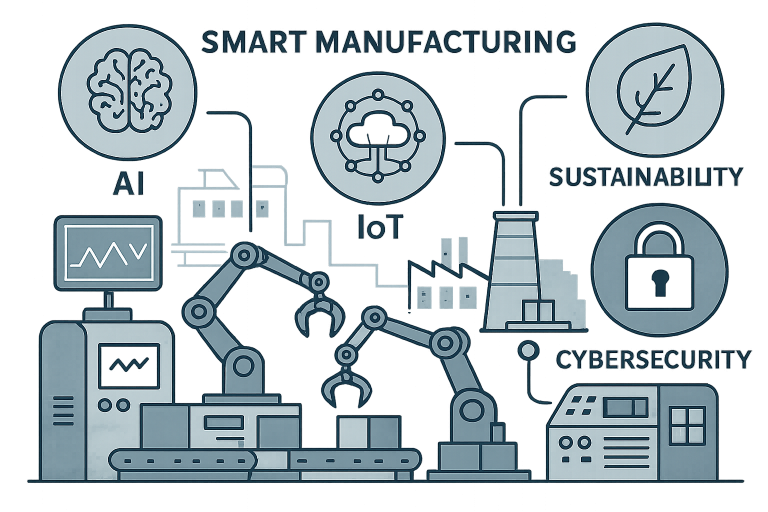Key Takeaways
- Advanced technologies like AI and IoT are redefining manufacturing operations and value chains.
- Eco-friendly and energy-efficient solutions are taking center stage in manufacturing best practices.
- Robust cybersecurity frameworks are vital as manufacturing environments become increasingly connected.
Table of Contents
- Artificial Intelligence Integration
- Internet of Things (IoT) Connectivity
- Sustainable Manufacturing Practices
- Enhanced Cybersecurity Measures
- Digital Twins and Virtual Simulations
- 5G Implementation in Manufacturing
- Blockchain Technology in Supply Chains
- Workforce Development and Training
Modern manufacturing is undergoing a profound transformation, driven by the rapid adoption of innovative technologies and interconnected solutions. Companies embracing automating strategies are realizing unprecedented gains in productivity, flexibility, and competitiveness. Staying ahead in this evolving landscape means integrating advanced operational technologies while adapting to emerging challenges, such as sustainability and data security.
Manufacturers that prioritize future-ready approaches place themselves at the forefront of a revolution—where real-time insights, more innovative processes, and digitally skilled workers define success. The following guide explores essential trends shaping smart manufacturing, outlining how businesses can utilize these developments to ensure resilience and growth.
The convergence of digital and physical systems has unlocked a new era for manufacturers. From AI-powered analytics to sustainable production and digital risk management, every innovation offers fresh opportunities—and new considerations. Navigating these changes means businesses must not only adopt cutting-edge tools but also reimagine their operational strategies and workforce capabilities.
The ongoing digital revolution in manufacturing is not without its challenges, especially as global supply chains grow more complex and consumer expectations shift toward transparency and social responsibility. Leaders in this space are already investing heavily in scalable technologies and talent development, positioning themselves for long-term success.

Artificial Intelligence Integration
Artificial Intelligence (AI) is fundamentally changing how manufacturers operate. AI systems analyze massive datasets generated by industrial sensors to optimize production lines, streamline supply chains, and enhance predictive maintenance. By automating quality control, manufacturers can rapidly spot defects, minimize waste, and improve product consistency. According to US News, AI is not only transforming industrial efficiency but also creating new roles in climate, energy, and environmental management, highlighting its broader societal impact. Recent industry reports indicate that up to 85% of manufacturers will incorporate AI applications by 2027, a testament to AI’s scalability and value. As AI becomes smarter, its role as the “brain” behind data-driven manufacturing will expand—enabling proactive, adaptive operations.
Internet of Things (IoT) Connectivity
IoT refers to the web of intelligent sensors and connected devices embedded throughout manufacturing plants. By continuously capturing real-time production data, IoT devices enable immediate responses to changing conditions on the factory floor. According to Investopedia, the Internet of Things connects devices and systems to streamline data collection and improve operational efficiency. Manufacturers use IoT-driven insights for schedule optimization, machine health monitoring, and energy management. One study on IoT adoption found that connected systems led to an 18% reduction in energy use and a 22% decrease in downtime, supporting both cost savings and sustainability.
Sustainable Manufacturing Practices
Environmental sustainability is a fast-emerging priority. Manufacturers increasingly leverage renewable energy, resource optimization, and recycling protocols as standard practice. These measures not only lower operational costs but also help companies meet regulatory requirements and satisfy environmentally conscious consumers. By 2026, many global manufacturers will have integrated robust sustainability metrics and circular economy models into their core production and logistics, aligning with broader ESG (Environmental, Social, Governance) frameworks.
Enhanced Cybersecurity Measures
The downside of a hyperconnected manufacturing environment is increased exposure to cyber threats. Industry data shows that in 2024, manufacturing accounted for over a quarter of all high-profile cyber incidents globally. Companies are now prioritizing layered cybersecurity defenses, regular risk assessments, and employee training to safeguard critical infrastructure and sensitive IP. As attackers grow more sophisticated, so too must the defensive measures—making cybersecurity a strategic necessity rather than an afterthought.
Digital Twins and Virtual Simulations
Digital twin technology, which mirrors a physical asset or process in a virtual model, is revolutionizing how products and factories are designed, operated, and maintained. By simulating real-world processes, companies can predict outcomes, identify optimization opportunities, and avoid costly trial-and-error learning. Digital twins are increasingly linked with extended reality (XR) platforms, providing immersive simulations that accelerate innovation while minimizing operational risk.
5G Implementation in Manufacturing
5G wireless connectivity significantly improves data transfer rates and network reliability. In manufacturing, private 5G networks enable seamless communication among IoT devices, robotics, and control systems—crucial for real-time monitoring and advanced use cases such as augmented reality-assisted maintenance. The adoption of 5G is unlocking smart infrastructure advancements, lowering latency, and future-proofing communication networks across large-scale facilities.
Blockchain Technology in Supply Chains
Blockchain’s immutable, transparent ledgers help manufacturers verify the origin, movement, and status of products and raw materials. This has major implications for sectors where authenticity, compliance, or ethical sourcing are critical. By providing a secure chain of custody, blockchain solutions reduce fraud, expedite recalls, and increase trust among suppliers, manufacturers, and customers. Rapid blockchain adoption is closely linked to the rising demand for resilient, traceable supply chains.
Workforce Development and Training
Technological innovation only succeeds when paired with a digitally fluent workforce. Upskilling programs that integrate technical, data, and digital reality skills are vital for empowering operators, engineers, and managers to leverage new platforms. Training in extended reality environments and hands-on digital tools prepares teams to keep pace with automation, analytics, and next-generation manufacturing processes. Investing in continuous learning helps companies stay agile as technology evolves.
Manufacturers adopting these trends are moving beyond traditional models, laying the foundation for responsive, sustainable, and future-proof operations. As digital convergence accelerates, those who embrace change—through investment in automation, digital infrastructure, security, and talent—will secure their leadership in tomorrow’s industry.






